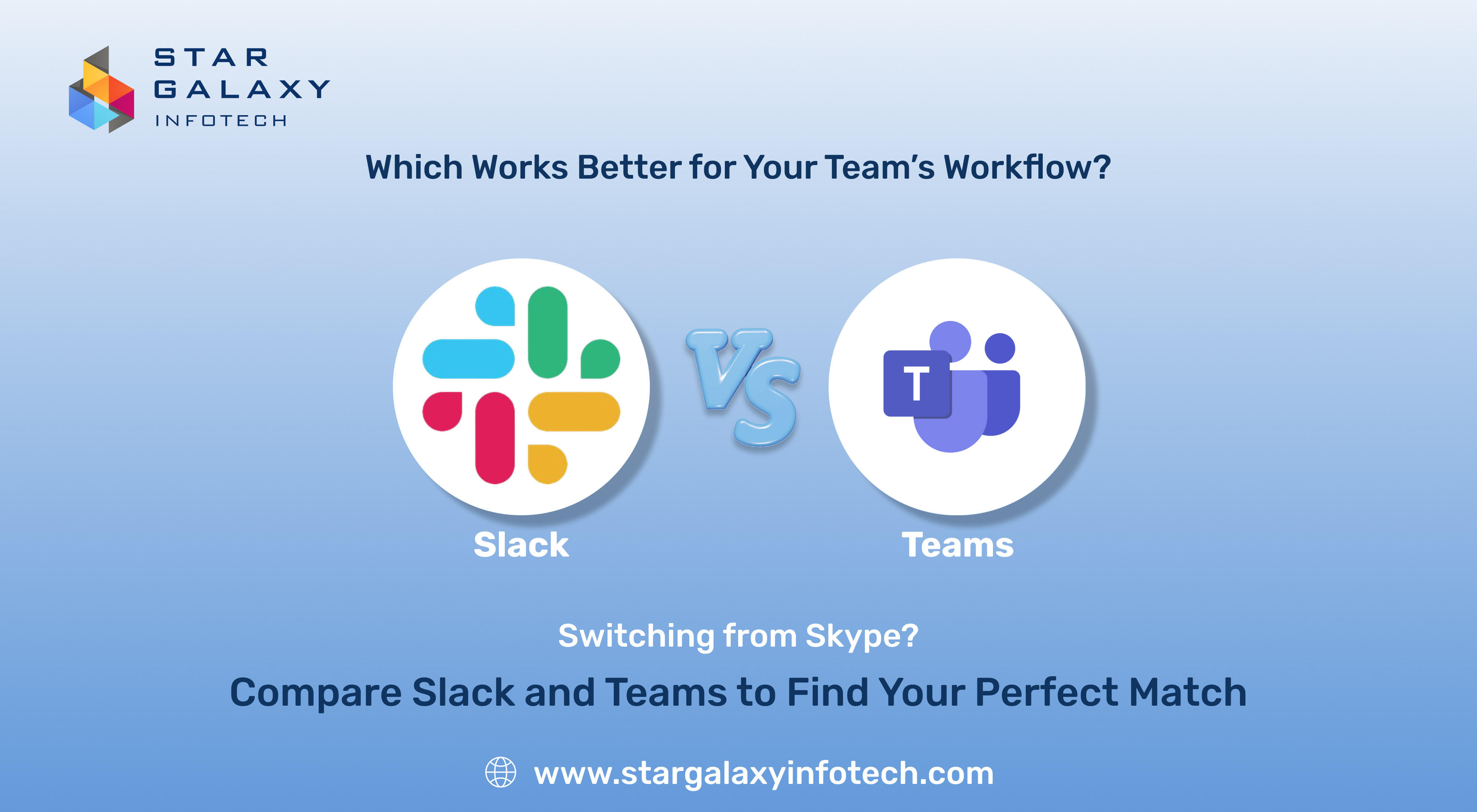 March 26, 2025
March 26, 2025
Star Galaxy Infotech

As we are aware, that Microsoft is shutting down its chat platform SKYPE, so most companies have to shift from Skype to other platforms like Microsoft Teams or Google Slack. Transitions are always challenging, and so is this one, because here all the work has to be shifted from one platform to another.
Both Teams and Slack are one of the world’s biggest communication platforms used for work purposes, they both are intuitive interfaces offering seamless communications.
So, to help you choose which messaging platform is better, let us have a look into this article and understand what are the benefits, pros and cons, Pricing and alternatives of Slack and Teams.
Slack vs. Microsoft Teams: A Comprehensive Comparison
User Interface and Experience
Both the platforms offer inbuilt interfaces that are designed to facilitate seamless communication. Google’s Slack highlights simplicity with customizable channels and a straightforward layout that fits to users who are seeking an uncluttered experience.
On the other hand, Teams integrates with the Microsoft 365 suite and provides a more feature rich environment that requires a sharp learning curve but offers extensive functionality for those familiar with Microsoft's ecosystem.
Integration Capabilities
Slack supports over 2,400 apps which makes it easy for teams to customize their workflow by connecting various tools like project management and social media platforms.
Though, Microsoft Teams offers fewer third party apps that seamlessly integrate with Microsoft 365 tools like Word, Excel and PowerPoint which makes it ideal for those already using Microsoft's services.
Communication Features
Both the messaging platforms support direct messaging, group chats and threaded conversations. Slack has a feature called “huddles” which provides quick audio chats for easy real time collaboration.
However, Teams extends its communication capabilities with powerful video conferencing features that support large meetings and webinars making it a great businesses that rely on virtual communication.
Security and Compliance
Security is the most important consideration for organizations. Microsoft Teams uses Microsoft's enterprise level security measures which include data encryption and compliance with various industry standards that appeal to sectors with strict regulation.
Slack also has good security but may need extra setup or add ons to meet specific compliance needs.
Also Read: Latest Web Design Trends for 2025
Benefits of Slack vs. Teams
Slack
-
Slack supports many integrations allowing easy customization for different workflows.
-
Its simple and user friendly design helps new users get started quickly.
-
A strong user community and detailed guides offer helpful support for troubleshooting and improvements.
Microsoft Teams
-
Teams provide a unified platform for organizations already using Microsoft services.
-
Features like co-authoring documents and integrated calendars make collaboration and scheduling easier.
-
It supports both small teams and large enterprises with scalable features.
Slack vs. Teams: Pros and Cons
Slack
Pros:
-
It supports many third party apps for customized workflow.
-
In Slack, users can adjust their notifications to reduce distractions and stay focused.
-
Works smoothly across different devices and operating systems.
Cons:
-
It might need extra integrations which will help in matching the built in features of competitors like Teams.
-
Its premium plans are expensive for larger organizations needing advanced features.
Microsoft Teams
Pros:
-
It provides durable experiences for users within the Microsoft 365 environment which enhances productivity.
-
Teams use the comprehensive security infrastructure of Microsoft which appeals to the strict compliance needs of organizations.
-
Has advanced video conferencing capabilities that support large meetings and webinars.
Cons:
-
The extensive feature might overwhelm new users who might need training and would take time to adapt.
-
It can be demanding on system resources that will impact performance on lower-end devices.
Slack vs. Teams: Pricing
Slack
-
Has Free Tier.
-
Pro Plan which is around $8.75 per user/month.
-
Business+ Plan at a price of $15 per user/month.
-
Enterprise Grid provides custom pricing for large organizations.
Microsoft Teams
-
It has Free Tier.
-
Microsoft 365 Business Basic is around $4 per user/month.
-
Microsoft 365 Business Standard at cost around $12.50 per user/month.
-
Office 365 E3 at $20 per user/month.
Slack and Teams Alternatives
As Slack and Teams dominate the collaboration space but there are some alternative that might fulfill varying organizational needs.
Discord
It was originally created for gaming communities, Discord has since been adapted to accommodate business communications, with voice channels, video calls and customizable roles, offering a versatile collaboration space.
Mattermost
It is an open source platform providing self hosted messaging solutions, Mattermost prioritizes security and customization making it ideal for organizations with particular compliance needs.
Google Chat
It is Integrated with Google Workspace, Google Chat offers an integrated communication platform with features such as direct messaging and group conversations.
Conclusion
When deciding between Slack and Microsoft Teams, organizations must evaluate their unique collaboration requirements and the current software landscape. Slack has deep third party integrations and an intuitive interface which is best for teams that want flexibility and customization. On the other hand, Microsoft Teams has seamless integration with Microsoft 365 tools and strong security capabilities which is suitable for organizations already committed to Microsoft's ecosystem. Assessing these elements will help companies choose the platform most suited to their operational needs and collaboration objectives.
 March 26, 2025
March 26, 2025
Star Galaxy Infotech
